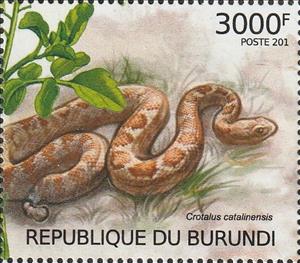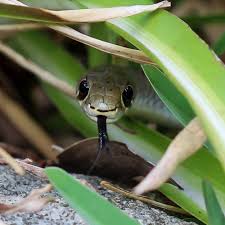Stamp: Crotalus catalinensis (Burundi 2012)
Crotalus catalinensis (Burundi 2012)
31 August (Burundi ) within release Reptiles Red List goes into circulation Stamp Crotalus catalinensis face value 3,000 Burundian franc
| Stamp Crotalus catalinensis in catalogues | |
|---|---|
| Michel: | Mi: BI 2563 |
| Belgium: | Bel: BI 1786 |
Stamp is square format.
Although this issue was authorized by the Burundi postal administration, virtually the whole issue was not sold in Burundi, but only distributed by the Burundi philatelic agency Stamperija for distribution onto the philatelic market. This issue is still being sold on the Stamperija website over a decade later as of the year 2024. This issue is extensively offered in online venues in mint condition. Stamps from this series are known used on commercial mail.Also in the issue Reptiles Red List:
- Souvenir Sheet - Glyptemys Insculpta face value 7,500;
- Mini Sheet - Reptiles Red List face value 8,140;
- Stamp - Reptiles Red List face value 1,070;
- Stamp - Acanthodactylus beershebensis face value 3,000;
- Souvenir Sheet - Acanthodactylus beershebensis face value 3,000;
- Souvenir Sheet - Acanthodactylus beershebensis face value 3,000;
- Souvenir Sheet - Astrochelys yniphora face value 1,070;
- Souvenir Sheet - Astrochelys yniphora face value 1,070;
- Stamp - Calumma tarzan face value 1,070;
- Souvenir Sheet - Calumma tarzan face value 1,070;
- Souvenir Sheet - Calumma tarzan face value 1,070;
- Stamp - Crotalus catalinensis face value 3,000;
- Souvenir Sheet - Crotalus catalinensis face value 3,000;
- Souvenir Sheet - Crotalus catalinensis face value 3,000;
- Stamp - Glyptemys insculpta face value 7,500;
- Souvenir Sheet - Glyptemys insculpta face value 7,500;
- Souvenir Sheet - Glyptemys insculpta face value 7,500;
- Mini Sheet - Reptiles Red List face value 8,140;
- Souvenir Sheet - Wood Turtle (Glyptemys insculpta) face value 7,500;
Stamp Crotalus catalinensis it reflects the thematic directions:
Animals are multicellular, eukaryotic organisms of the kingdom Animalia (also called Metazoa). All animals are motile, meaning they can move spontaneously and independently, at some point in their lives. Their body plan eventually becomes fixed as they develop, although some undergo a process of metamorphosis later on in their lives. All animals are heterotrophs: they must ingest other organisms or their products for sustenance.
Reptiles are tetrapod (four-limbed vertebrate) animals in the class Reptilia, comprising today's turtles, crocodilians, snakes, amphisbaenians, lizards, tuatara, and their extinct relatives. The study of these traditional reptile orders, historically combined with that of modern amphibians, is called herpetology. Because some reptiles are more closely related to birds than they are to other reptiles (e.g., crocodiles are more closely related to birds than they are to lizards), the traditional groups of "reptiles" listed above do not together constitute a monophyletic grouping (or clade). For this reason, many modern scientists prefer to consider the birds part of Reptilia as well, thereby making Reptilia a monophyletic class.
Snakes are elongated, limbless reptiles of the suborder Serpentes Like all other squamates, snakes are ectothermic, amniote vertebrates covered in overlapping scales. Many species of snakes have skulls with several more joints than their lizard ancestors, enabling them to swallow prey much larger than their heads (cranial kinesis). To accommodate their narrow bodies, snakes' paired organs (such as kidneys) appear one in front of the other instead of side by side, and most have only one functional lung. Some species retain a pelvic girdle with a pair of vestigial claws on either side of the cloaca. Lizards have independently evolved elongate bodies without limbs or with greatly reduced limbs at least twenty-five times via convergent evolution, leading to many lineages of legless lizards. These resemble snakes, but several common groups of legless lizards have eyelids and external ears, which snakes lack, although this rule is not universal (see Amphisbaenia, Dibamidae, and Pygopodidae).



